One day we went on tour. First, the little village of Anthé, just down the road – but, to be fair, there really isn’t much there. On to Tournon d’Argenais. Another town built on the top of a hill. This time we got most of the elevation sorted by car as the road spiralled upwards around the outside of the defensive walls of the old town. We’ve been here before, but it’s always nice to be reminded of places. We walked most of the town’s narrow streets and ended, after much deliberation, at Les Mirabelles for a crèpe! I know, we are a long way from Brittany, but it has to be done occasionally to remind us how nice they taste, but how many you need to make a meal!
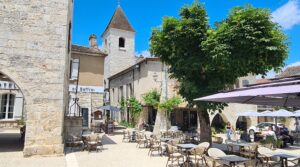
The Eglise Saint-Barthélemy. Another freely accessible church:
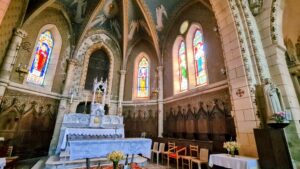
Barthélemy brings our French “saint count” (churches and towns etc.) to a very respectable 200. That only leaves another 1176 saints to meet before we catch the ferry! I discovered that there are three countries that recognise more goody-goody-two-shoes than France!
(For the record, North Africa leads the canonisation league table with an astonishing 5,081. Spain comes a poor second with a miserly 2,407 and then Italy with just 1,897 – just ahead of France at 1,376. In total, over 10,000 saints are recognised world-wide.)
Montaigu de Quercy is yet another town built on a hill, or more precisely, on the side of a hill. A long steep approach, up the main street …
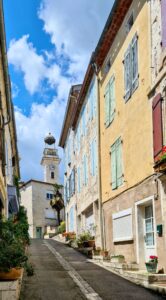
… which appeared to be devoid of residents, brought us to an open square at the top of town.
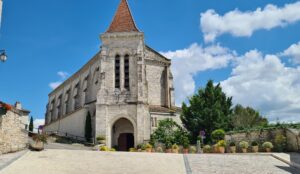
The only people moving here, apart from us, were two gardeners, replacing winter planting with stuff suitable for a hot dry summer. And, of course, the compulsory church is located up here. But no sign of a café, a bar, a shop, or anything really!
So, that’s Montaigu de Quercy ticked off! To be fair, outside the historic centre there was a small grocery store (closed), a garage (closed), a pharmacy (used to get cough medicine), a bank (somewhere not seen on this visit, but used later in the week), an estate agent (closed) and a very useful public toilet!
Another day we made a plan to eat at the tiny restaurant, Au P’tit Moissac. Highly recommended. Miles out in the boondocks. But we have their telephone number and the name of the village, Touffailles. We got no reply when we rang. We took a bit of a gamble! We headed to Touffailles. Here we found no sign of the restaurant, indeed, not much sign of anything, really. We drove out of town on each of the possible roads, but still no signs. On returning to “down-town Touffailles”, an English lady careered out of her house (the only one of the six houses that looked as if it was lived in). “Can I help you. You look lost!”. “Ahh, Au p’tit Moissac. Very good! You need to go to up that narrow road to the top of the hill. Then zig zag down the other side. Past the lavender farm. Cross the stream. Keep going to Moissaguel about ten kilometres. Then from the centre of the village (five houses, I counted!) follow the signs”. Well, there are five roads and two tracks leave the “city” of Moissaguel. We follow each in turn for upwards of five kms. No signs. No cars. No nothing! But we did spot a couple of deer down one road. We felt we were on first name terms with Dasher and Prancer after we had passed them for the fourth time in 20 minutes. It transpired they were captive deer not wild ones.
In the end, we decided to knock on one of two houses showing any sign of life. I got an absolute earful from the resident “I’ve told him he MUST put up a sign.” And after a long and tedious rant, very reluctantly, “It’s to the right at the crossroads.” “Merci monsieur! I’ll mention the lack.of signs.” Luckily, I don’t have a commanding knowledge of French swear words, but I’m pretty sure I heard quite a few!
Anyway, to keep a long story long, we turned right at the crossroads. We checked both houses we passed, very carefully. One looked deserted and about to fall down. The other looked to be occupied, but absolutely not a place at which I’d want to eat. So we went further and met up with Prancer and Dancer and several of their friends yet again before returning to the centre of Moissaguel. “Let’s try the house at which we wouldn’t eat.”
A very pleasant elderly gentleman hobbled to his (open) front door snd told us to take the track immediately behind his house for a few hundred metres. Bingo, lots of cars jammed under trees. Too many, it transpired. The restaurant was full and Claude, the mad Belgian, was cooking and serving all his customers on his own.
“Signs? Why? I’m full every day for the next three weeks! I don’t need signs, my customers all know how to get here – and anyway, I haven’t got time to put them up!” I think that’s what he said. That and “Desolé!”
As we pulled out of his garden, the car’s tyre pressure warning light came on. Well, it was a very rough track. While I was checking pressures, parked in the access drive, a delivery van arrived. He just had to wait while I convinced myself we didn’t have a seriously flat tyre.
We ended up in Bourg de Visa at La Brasserie des Cornières. It was late. They had officially stopped serving 15 minutes before we arrived. The owner turned out to be a bit of a jester. Rather than show us a menu or describe the available offerings, he asked us what we would like to eat and then cleverly steered us towards the only thing available. A rather tasty spag bol!
After that little episode, we debated going further South to Moissac town (as far as we knew, nothing to do with the hard-to-find P’tit Moissac restaurant. But I bet there’s a connection there somewhere!). I wanted to see the “famous” aqueduct carrying the Canal Lateral à la Garonne (that we had met several times previously) over the River Tarn. The Pont Canal du Cacor. Glenda wanted to see the city. A clear compromise. City first. Bridge second. But it’s a goodish drive, we’ll be late home!
The city turned out to be smaller than we expected. Dominated by a whacking great cathedral/Abbey thing.
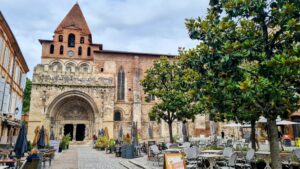
The Abbaye Saint-Pierre de Moissac. A combined Romanesque Abbey and working church.
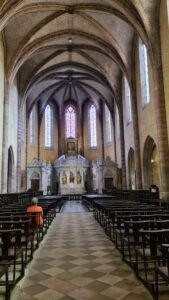
A very busy, working church. We are beginning to realise that most churches were built off the same architectural plan. They really do have a lot in common. Massive pillars, disproportionately tall vaulted ceilings, tall stained glass windows and millions of chairs. They are also all lovely and cool!
This one has an added feature. We thought it was the desk where we were going to have to pay for visiting.
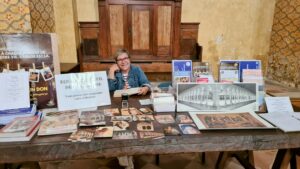
But, no. Meet Edith, the keeper of the tampon. It is she who stamps your record card to prove you have completed this section of the dreaded Camino Trail. She stamps it with her tampon. Obviously!
Moving swiftly on, we find the Pont Canal du Cacor a few kms out of town.
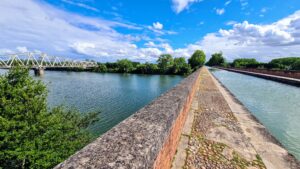
Built in 1844/5 it is, at 356 m long, one of the longest such aqueducts in France.
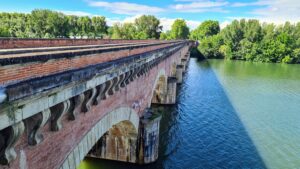
There is also the famous Saint Jaques swing bridge on the canal in Moissac. But sadly, it wasn’t famous enough, because we didn’t know about it at the time. So we didn’t visit.
The other spectacular feature of this canal is a “water slope”. Replacing a flight of five locks, this engineering masterpiece uses two powerful tractors to pull a large puddle of water (with a boat – up to 40 m in length – floating on it, obviously) up a slope. The waterproofing of the “puddle” must be impressive. Sadly, this feature is located in Montech another 30 minutes away from camp. Also, it hasn’t been working since 2009. Two reasons to skip a visit.
We already had over 50 kms of country roads to get home. As predicted we were late back. Hetty was about to send out a search party. She had some stern words about old people not staying out late at night!
I’ve searched hard, but I can find no reference to a Sainte Hetty! But France did have a Queen Henrietta!
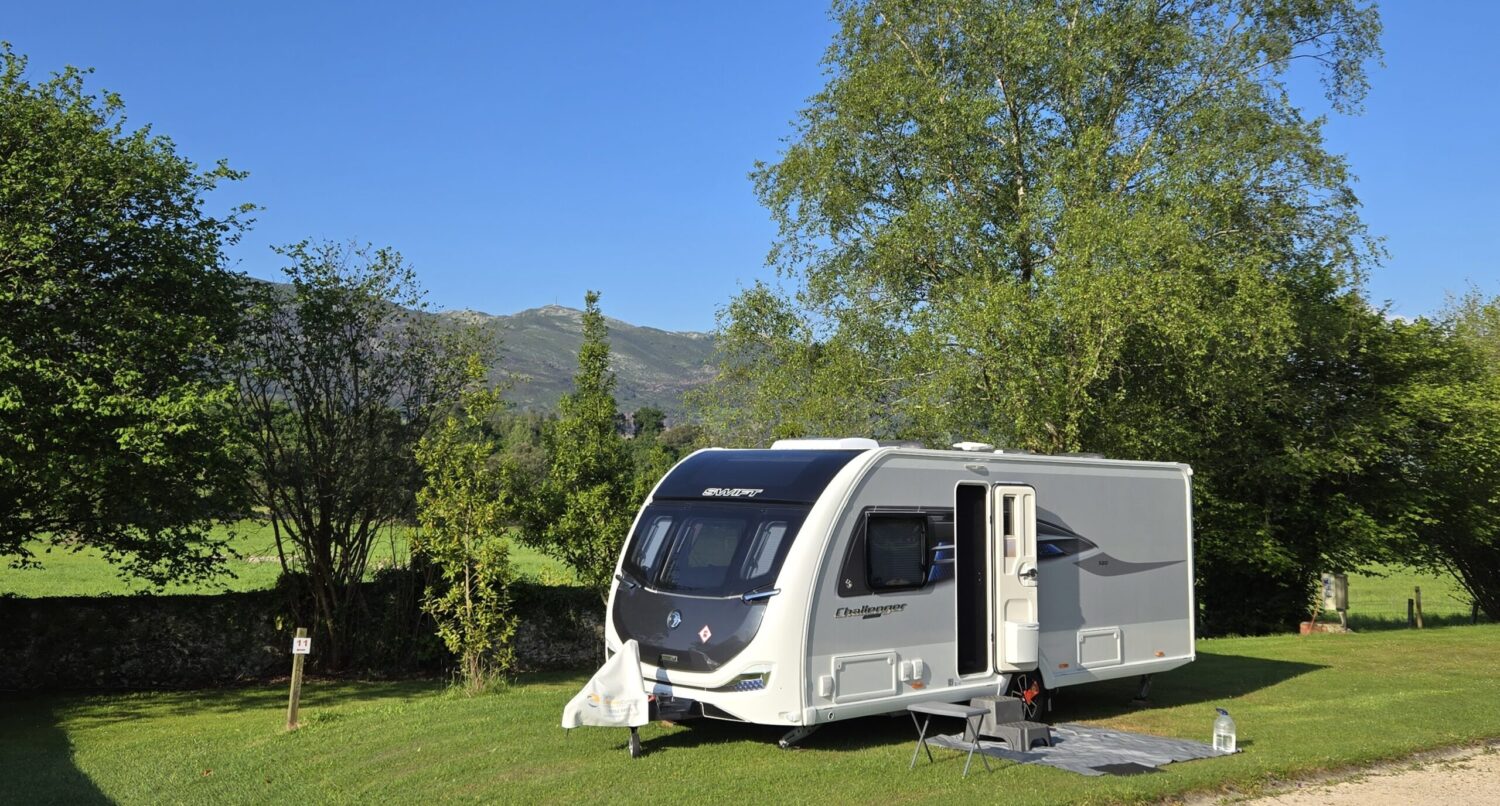
Ha ha…..I can just hear Hettie giving you a good telling off and sending you to your bedroom……lol.
Cathie Xxxxx xX ❤❤
We must be an unholy lot in Australia!
We have just recently made that leagues table. We have 1 saint ….. Mother Mary McKillop (she only made the esteemed list in the new millenium.